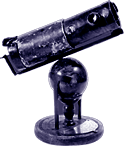
 Telescopes: Our eyes on the universe
Telescopes: Our eyes on the universe
by Kelly
LaMarco
Adapted from the print edition of Exploratorium Magazine
Credit
for inventing the telescope
usually goes to Hans Lippershey, a Dutch optician. Lippershey,
who revealed his device for seeing things at a distance
in 1608, probably intended that it would be used primarily
by sailors. Word of the instrument traveled to the famous
scientist Galileo Galilei in Italy, who decided to make
his own. One night in 1609, Galileo turned his telescope
to the heavens
—
and
changed astronomy forever. Telescopes, even very early ones,
revealed information about the celestial entities that no
one had previously imagined. Since then, astronomers have
used telescopes to study everything from our moon to comets,
star clusters, and distant galaxies. And with a telescope
that's currently in the planning stages, astronomers hope
someday to see to the very beginning of the universe.
Most telescopes
work in essentially the same way, producing an image of
a distant object inside a tube; we can then look at the
image through an eyepiece. A telescope helps us to perceive
faraway elements, not primarily through magnification, as
commonly believed, but through its ability to collect light.
The amount of light collected by a telescope determines
the level of detail we can discern and is related to the
size of its light-collecting component, commonly either
a lens or a mirror (referred to as the telescope's "primary
optics"). The larger the light-collecting component, the
greater the telescope's light-gathering ability and, therefore,
its "resolving power." Resolving power is the ability of
the telescope to show two adjacent objects, such as "double"
stars or a planet and its moon, as separate, distinct images.

Because
he couldn't overcome the problem of chromatic aberration,
Sir Isaac Newton decided to use a mirror in a telescope
in place of a lens. The result was the first reflecting
telescope, which he invented in 1672.
|
The eyepiece,
which consists of two or more lenses mounted in a cylindrical
metal barrel, acts like a magnifying glass held up to the
image produced by the primary optics. The magnifying power
of a telescope (for example, 20X or 20-power) can be altered
by changing the eyepiece.
Modern optical
telescopes fall into two general categories: refracting
telescopes, such as the land-based 91-centimeter (36-inch)
refractor at the Lick Observatory near San Jose, California;
and reflecting telescopes, including the Hubble Space Telescope.
The Hubble Space
Telescope (HST) is a large reflecting telescope that was
designed by NASA to be a space-based observatory with a
life expectancy of about fifteen years. Set into orbit in
1990, its position high above the earth's atmosphere means
that it doesn't have to contend with particles in the air
and air movement that distort the view from ground-based
telescopes. The Hubble has brought us startling images of
the moons of Jupiter, the rings of Saturn, and nebulae alive
with the light of newly formed stars.
An important
feature of the HST is its sensitivity to ultraviolet light
(UV). UV is absorbed by molecules in the earth's atmosphere.
Because the HST orbits above the atmosphere, it's able to
make observations in ultraviolet light. The UV portion of
the spectrum provides information about the properties of
celestial bodies, such as their chemical compositions.
The HST's space
mission will end in a decade or so, but NASA has not been
idle. The Next Generation Space Telescope (NGST), part of
NASA's Origins Program, will be the successor to the HST.
The ultimate goal of the NGST is to gain an understanding
of how our universe evolved after the Big Bang. Because
the light that comes to us from the very distant first stars
and galaxies in the universe has a frequency lower than
the frequency range of visible light, their study requires
observations to be made in the infrared portion of the spectrum.
The NGST is designed to have these capabilities, unlike
the HST, which operates from the ultraviolet to the near
infrared.

|
Hubble
is a reflecting telescope with a primary mirror
that is 2.4 meters (94.5 inches) wide, smaller
than the largest observatory telescopes. But because
it doesn't have to contend with atmospheric distortion,
the resolution of Hubble is about ten times greater
than high-quality ground-based telescopes.
|
|
But you don't
have to be part of a NASA mission to study the stars. Astronomy
is one area of science where amateurs regularly contribute
to the body of knowledge. Amateur astronomers all over the
world have their telescopes poised to discover new comets
and to patrol distant galaxies for supernovas. Amateurs
also watch selected "variable" stars
—
stars
whose brightness varies in a cyclical manner
—
and
take down data such as how bright the star is at different
times. They then send the data to professional astronomers,
who use the information in their research. Another astronomical
activity that is gaining popularity is watching the sky
for space objects such as comets and asteroids. The popular
press has made the public aware of such potential visitors,
and increasing numbers of people are on the lookout for
so-called "near earth orbit" objects (NEOs).
If you simply
want to use a telescope to enjoy the beauty and mystery
of the heavens, you can view the four largest moons of Jupiter
and the rings of Saturn through most commercially available
telescopes. With respect to constellations, the seasonal
skies provide a changing light show. During the winter in
the Northern Hemisphere, Orion is a prominent constellation,
containing the red star Betelgeuse and the spectacular greenish
clouds of the Orion nebula. The Ursa Major or "Great Bear"
constellation, whose seven brightest stars form the Big
Dipper, is prominent in the Northern Hemisphere's summer
sky. But there is no reason to limit your viewing to the
constellations, however wondrous they are. Also starring
in each evening's performance are planets, nebulae, and
our moon. Enjoy the show!

|
![]()
![]()